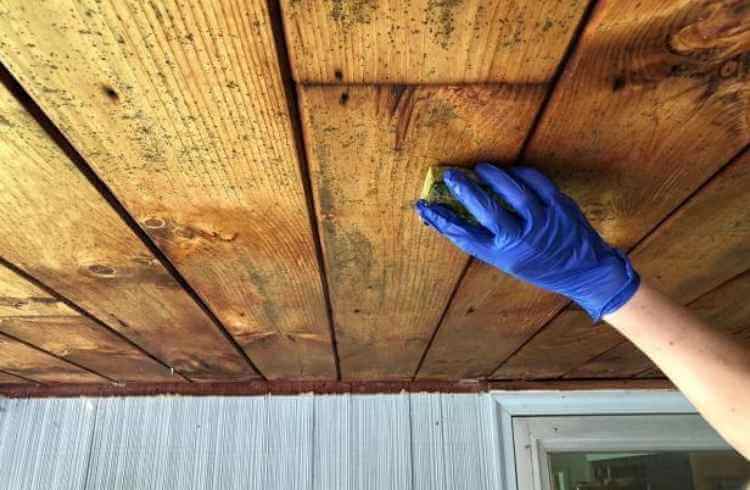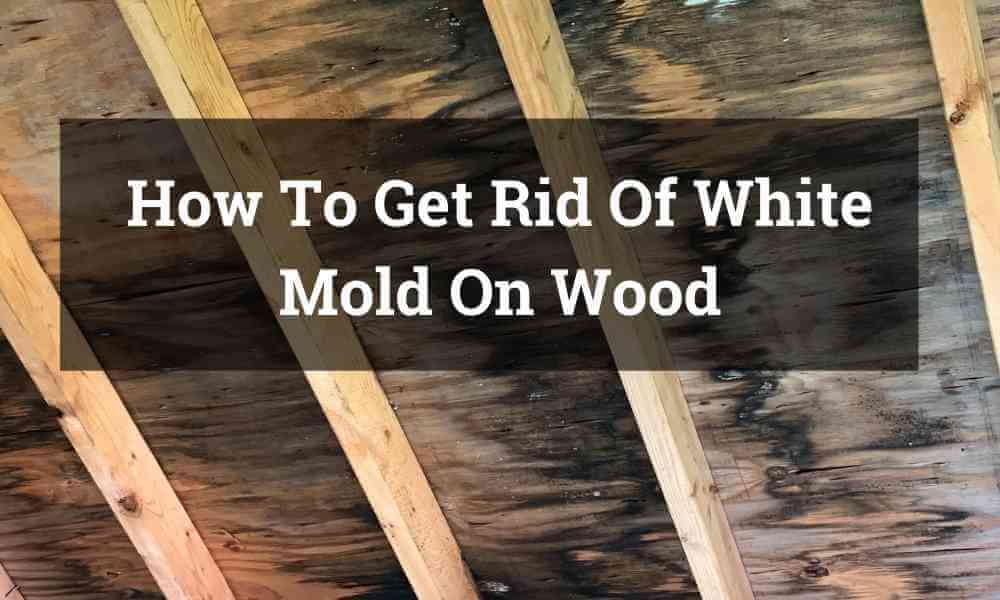Are you thinking too much about white stains on your furniture?
Don’t know what is it? Keep rolling to know the truth!
Typically, visible white stains on wooden objects are signs of the growth of fungi, especially of genus Ramularia or Erostheca. It is a kind of common wood infection called white mold that can even affect humans. So, treat it before it penetrates deeply. Let’s see how you can control white mold effectively.
How to get rid of white mold on wood? There are two ways of treating white mold growth on wooden structures. You can treat the affected area simply by vinegar, baking soda, and dishwashing detergent. For heavy mold infection, chemicals like hydrogen peroxide and chlorine bleach work well.
Mainly humidity is the main thing that is responsible for the production of white mold. If you want to remove it permanently, you should try to make your homes well ventilated.

Most Affected Areas of White Mold
There are so many types of mold based on color, species and other factors. White mold mostly targets both indoor and outdoor wooden structures.Let’s see the details of suspected areas where you can find it mostly
Furniture
Furniture gets exposed to this mold quickly. Especially cupboards of thin wooden sheets, sides or backs of dressers are its main target. The reason might be that such areas are placed towards walls and get less air
Outdoor Attic, Fencing, Framing
Outdoor wooden attic or rainy areas absorb more humidity from the air. If not painted, mold can attack quickly. Similarly, wooden fencing and framing also develop mold in moisture. Crawlspaces of certain wooden framing accommodate humidity from the air and here mold disease is not easy to trace.
Top Ways Of Getting Rid Of White Mold
There are two basic solutions to restrict and eliminate white mold growth. First is a simple solution that you can do with household items. This type of solution is best for removing mold from a small area. The second needs chemicals and is good for extensive mold growth in larger areas.
- A simple solution of killing white mold
- Use of chemicals for killing molds
#1. A Simple Solution Of Killing White Mold
The good news is that there is a simple household solution available for this complex problem. These items are non-toxic, non-allergic and environment friendly. In my opinion, these are like medicines with no side effects at all. You can find these items in almost every home
- Vinegar
- Baking Soda
- Dishwashing detergents
Let’s start with vinegar
1.Vinegar
Vinegar comes in different colors and brands. It may confuse you with what to use. Almost all types of vinegar have acidic qualities. But for cleaning purposes, I would recommend you to use white vinegar that can kill more than 80 % species of mold. Follow these steps for cleaning mold in this
- First, clean the mold marks properly with soft scrub
- Put vinegar in spray water
- Spray it on the infected area
- Let the vinegar stay there for at least 30 minutes
- Wash it with detergent and let it dry
2. Baking Soda
If you try baking recipes frequently then you will be familiar with it.
Baking Soda comes in a white mineral powder form. When dissolving in water it serves as an effective cleaning agent. It has an excellent ability to dissolve moisture. One advantage more, it is mildly acidic and safe for pets. Follow the steps to use it as a mold killer
- At first clean the infected area with the foam or piece of cloth properly
- Add one-quarter tablespoon of baking powder in water
- Mix well and then pour this mixture in a spray bottle
- Spray the area and let it absorb for 30 minutes
- Clean it with a soft bristle brush
To get more cleaning effect you can add vinegar also
3. Dishwashing detergents
Dishwashing detergents are anti-viral,anti-fungal as well as anti-bacterial. You can use them for cleaning mold stain also as they are mild. However, it may not work well if the problem is because of leakage. You need to fix leakage issues to get good results
- Clean the infected area with a dry cloth
- Pour a few drops of detergent on each marks randomly
- Scrub it for few seconds with soft scrub
- Wash it with distilled water and dry the area properly
#2. Use Of Chemicals For Killing Molds
What to do if household items are not killing mold? Don’t worry, chemicals are there. But be careful they can harm your pets and are toxic. Let’s see how you can treat moldy surfaces through chemicals.
1. Hydrogen peroxide
Hydrogen peroxide provides a protective coating against fungal, viral and bacterial infections that kills mold effectively. It works well on a variety of materials such as kitchen appliances, bathroom fixtures, floors, and walls
Step to Use hydrogen peroxide
Though this chemical is non-toxic, it can cause allergic effects. So always use a safety glove and face mask to start this procedure. Follow the steps below and watch the video below.
- Clean the affected area with a soft cloth.
- Pour a 3% solution of concentrated hydrogen peroxide into a spray bottle.
- Spray it gently on the infected area
- Wait to at least 2 minutes to absorb well
- When it starts changing color, scrub it with foaming scrub.
- If mold marks are still there, repeat the process again
2. Chlorine bleach
What to do if the mold has left permanent stains? Its time to try a chlorine bleach solution.
It works well on larger areas as wood flooring. So you can use this method for bathroom accessories mold removal. Always buy good scent, high-quality chlorine bleach
Steps to Use Chlorine bleach
This bleach is smelly enough. So, put on goggles, a mask as well as gloves to protect yourself from an allergic reaction.
- Clean all visible spores on the affected area with a vacuum.
- After cleaning, wash the area with dishwashing detergent and dry it using the sponge
- If stains are still there, prepare a mixture of half cup chlorine with warm water
- Spray the mixture if the area is not bigger. For larger area drop on the stains directly.
- Clean it using a soft bristle brush
- All the stains and blackish marks will disappear.
- Finally, dry it with a cloth.
In order to check what product works well bleach or hydrogen peroxide. Watch this simple testing video
When To Get The Help Of Professional
What if all of the above solutions fail to disinfect wood and mold still keep growing?
It’s time to call professional mold remover. If the problem occurs in humid and less ventilated damp places, it may arise again. Experts know well in this situation how to handle it. They would reinstall the infected wooden structures after dispose of the old carefully. They suggest if mold covers 10 or more square feet of the surface then its time to get help. One more thing, the health department also offers mold testing in case of allergic symptoms. According to the results of the test, they may refer you to mold experts.
Related article: 11 tips for how To Get Rid Of Water Rings On The Wood
Tips For Preventing Mold
Nowadays builders insert chemicals before constructing homes at the foundation. This works well to dehumidifier walls. If your home is well ventilated then you can decrease the risk of mold attack. Here are a few tips to prevent it from growing further
- Humidity is primarily responsible for causing indoor mold damage. To control this problem, let the wet areas dry with a dehumidifier, fans or opening windows. After washing the home or cleaning the bath, keep the fan on until water dries completely. In the rainy season, ventilate your home well.
- Leakage, holes, and cracks are silent mold boosters. Water keeps on penetrating from cracks rising moisture gradually. Keep an eye on plumbing holes, floor leaks and fix them before they became infected.
- Cover the fungus at the beginning. Don’t let it stay longer. If you observe moldy marks on indoor furniture, cabinets, clean it properly. By detecting the problem at an early stage, you can avoid big damage later.
- Frequent exposure of wooden structures to sunlight can also help to prevent mold.
Does White Mold Cause Rot?
Typically no, if you treat the mold regularly, it can not cause rot. However if untreated and moisture level elevates gradually, then it can cause rot. So, It is recommended to solve this problem at an early stage to avoid further damage. Rot needs a high level of moisture as compared to mold.
Watch this interesting video to clean up attic mold
Is White Mold Harmful?
Many types of molds can increase the risk of allergic reactions in sensitive individuals. For them, living close to the infected area is not safe. Doctors mostly refer to a mold test to trace allergic symptoms. For this reason, it is advised to remove and dispose of mold growth properly.
What Tests Are Used To Identify White Mold
There are different types of mold testing according to the species, color, and other factors. Names of three main testing types are
- Air Sampling
- Direct Sampling
- Bulk Sampling
For identifying white mold, direct sampling is used. To get a sample, swab or a small piece of the affected area is taken out and sent to the laboratory for analysis. At first, the lab will verify the mold growth and then species.
Related Question
What kills white mold on wood?
To kill white mold on wood use vinegar, baking soda, chlorine bleach, and hydrogen peroxide solution.
Is white mold on wood dangerous?
Yes, white mold can cause allergic reactions, respiratory infections, eye irritation and even nauseous.
What does white mold look like on wood?
White molds look similar to mildew. However, mildew is not harmful as it is an early stage of infection.
Can you clean mold off wood?
Yes, you can clean the mold using scrub or cloth. You can also wash it with detergent, vinegar, chlorine bleach, and many more products
What is white fungus on wood?
White fungus on wood can be mildew or white mold. Mildew is the early growth stage of white mold. But it is harmless.
Final Verdict
For humid areas, it is essential to know how to get rid of white mold on wood. This article focuses mainly on the simplest and cheapest ways of treating this fungus. For indoor furniture mold, try vinegar, detergent and baking Soda. Use hydrogen peroxide and chlorine bleach if the vast area is infected. Always treat this problem at an early stage. I hope you would get the advantage of these ways of curing white mold.


